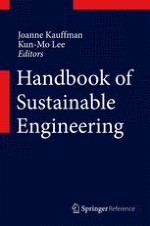2013 | OriginalPaper | Chapter
65. Thermodynamics and Resource Consumption: Concepts, Methodologies, and the Case of Copper
Author : Dr. Stefan Gößling-Reisemann
Published in: Handbook of Sustainable Engineering
Publisher: Springer Netherlands
Activate our intelligent search to find suitable subject content or patents.
Select sections of text to find matching patents with Artificial Intelligence. powered by
Select sections of text to find additional relevant content using AI-assisted search. powered by
